
 I recently had the pleasure of hosting a CB&A Expert Series event with Sara Kloek, vice president, education and children’s policy at the Software & Information Industry Association (SIIA), during which we discussed current policy details and implications that education companies need to know in the upcoming year.
I recently had the pleasure of hosting a CB&A Expert Series event with Sara Kloek, vice president, education and children’s policy at the Software & Information Industry Association (SIIA), during which we discussed current policy details and implications that education companies need to know in the upcoming year.
With use-it-or-lose-it COVID relief fund deadlines approaching, districts must soon determine how they should spend their remaining stimulus dollars. And a divided federal government means that education priorities and policies are all over the map. Accordingly, 2023 is another crucial and active year for education policy, funding and spending.
We’ve recapped some essential insights from our conversation below, and invite you to watch the full event recording: Making Sense of Education Policy.
Education Policy Update
Department & Funding News
President Biden released his Fiscal Year 2024 budget proposal to the public on March 9th, 2023. While Congress will ultimately approve a final budget after significant negotiation, Biden’s proposal is a general indicator of where his administration would like to see them focus their efforts. This year, President Biden wants to prioritize initiatives like:
- Providing more professional/work-based learning programs
- Expanding high-quality Pre-K education
- Investing in school-based counselors
- Investing additional money into the Individuals with Disabilities Education Act (IDEA)
- Increasing funding for Title I schools by $2.2 billion
While Congress debates upcoming funding priorities, many schools and districts are still focused on several existing federal funding programs. The September 2024 deadline for ESSER III/ESSER ARP funds has prompted attention and conversation among state and local decision-makers.
Sara also shared that the U.S. Department of Education has recently signaled that it is focused on tackling how to:
- Develop a national education technology plan
- Determine how artificial intelligence could impact education
- Reflect on how students’ civil rights protections were affected during the pandemic
- Collaborate on additional congressional oversight of education programs
- Protect college students when they use technology
The Federal Trade Commission is looking to provide updates to the Children’s Online Privacy Protection Act. In addition, higher education institutions are concerned with the impact of third-party and foreign technology on their students. Therefore, the government wants to conduct more audits of current higher education technology and consider restrictions on which third-party apps college students can use.
Both initiatives could affect a wide range of education technology vendors across the entire PreK to higher ed spectrum. SIIA is working with its edtech members to provide insight to policy makers on how they can balance privacy protections without hampering the innovation these products provide.
Legislative Acts
Sarah provided insight into two key pieces of legislation that are under consideration:
- Parents Bill of Rights Act: This act requires that districts post curriculum for parents to review, along with the right of parents to object to using technology in the classroom. Schools are also required to notify parents of their various rights. This bill passed a House vote on March 24th, 2023. Many edtech companies are concerned about protecting their intellectual property / copyrighted materials in a scenario where all materials are publicly posted.
- Kids Online Safety Act: This bill was initially aimed at regulating social media companies by limiting children’s time on apps like TikTok, Instagram, etc. The updated bill added educational services as a part of the covered entities. Parents could opt out of algorithmic recommendations and have access to tools to monitor their child’s platform usage at school. A subcommittee hearing in February passed the bill with bipartisan support. Many states have already introduced similar policies attempting to limit child data access. Questions remain about which type of educational software would apply, how usage would be tracked, and who would track it.
Knowing the current state of education policy and funding priorities helps B2E businesses adapt their focus and approach to maximize opportunities and success. I hope you’ll find ways to apply Sara’s insights to your work this year and beyond.
To learn more about current education policy news and updates from Sara, watch our CB&A Expert Series event: Making Sense of Education Policy.

